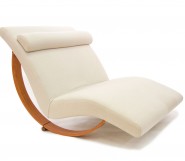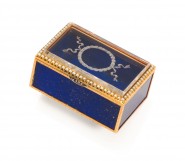Lot #3 - John Olsen
-
Auction House:Deutscher and Hackett
-
Sale Name:Important Australian + International Fine Art
-
Sale Date:04 May 2016 ~ 7pm
-
Lot #:3
-
Lot Description:John Olsen
born 1928
Kitchen, Influenced By Flowers
watercolour and pastel on paper
95.0 x 100.0 cm
signed and inscribed lower left: Kitchen Influenced by Flowers / John Olsen -
Provenance:Private collection, Melbourne ; Leonard Joel, Melbourne, 9 April 1997, lot 174; Christie’s, Melbourne, 26 August 1997, lot 18A ; Gene and Brian Sherman collection, Sydney
-
Notes:John Olsen is the celebrated bon vivant of Australian art. His love of fine food and wine colours his reputation and has informed his work for decades. A fascinating aspect of Olsen’s work is that he extends his love of the kitchen into his studio. In short, Olsen paints in a similar way to how he might cook. Food writer Andy Harris writing in an introduction to Olsen’s 2010 exhibition, The Culinaria, Cuisine of the Sun, at the Tim Olsen Gallery, describes having breakfast with John Olsen: ‘... we had the perfect early morning breakfast perched on the stools of the tiny El Quim bar, eating their famed chipirones (baby squid) with fried eggs, cutting them into a rough dice to produce a gloriously artistic mess of egg white and runny yolk mixed with intense smears of black squid ink, emerald green olive oil and sprinkled paprika. Accompanied by perfectly thin olive oil fried chips and cold Quilmes beer, his eyes sparkled as he began to draw in his notebook.’1 Kitchen Influenced by Flowers tells the story of a simple lunch but takes on an inspired urgency as we see every aspect of the activity at once. It is as though the entire event occurred simultaneously. The application of the watercolour in particular takes on the feel of cooking stains as they spill their way around the surface as Olsen’s playful repertoire of mark making adds to the jovial richness of the work. The picture presents the kitchen as the engine room of family life. Typical of Olsen, this work is abundant with anecdotes about the event; the family cat scrounges for scraps, a mouse scarpers, the table is scattered with the ingredients of the meal and a warm egg yolk yellow light floods the scene. It has all the elements of a well told story, the details unravel across the surface to complete the yarn in a manner which is unmistakably Olsen. 1. Harris, A., Culinaria: The Cuisine of The Sun, Tim Olsen Gallery, Sydney, 2010, p. 7 HENRY MULHOLLAND 160319 AKIO MAKIGAWA (1948 – 1999) UNTITLED, 1999 ‘As objects, works of art and sculptures, Akio Makigawa’s works have an exquisite symmetry, an assured presence and above all a sublime instinct for the opportunities of material, a quality that is very much in his cultural inheritance.’1 Untitled, 1999 is a captured moment of suspense. Makigawa presents two seed-shaped vessels on the brink of its octagonal base. He purposely rests their sharper side on top of each other instead of being perfectly nestled on their seemingly balanced base. Despite the uncertainty in their placement, Makigawa cleverly presents Untitled, 1999 with flawless balance and a quiet elegance. He alludes a meditative calmness and poise in his figures but its construction required activity and energy as the figures teeter on a single point. 2 From 1998 to 1999, Makigawa produced smaller scale sculptures motivated by the theme ‘Beginning’, expressing ideas of life, growth and spirituality. ‘Beginning’, comprising of figures of seeds, bowls, and houses, was Makigawa’s final series of works before his passing in December 1999. Widely known throughout his artistic career for his large scale corporate and public commissioned sculptures, Makigawa took an intimate turn in his solo exhibition crafting universal and personal symbols that would evoke reflection and spirituality. Nine Lives exhibited at Anna Schwartz Gallery in Melbourne encapsulated the peaceful elegance of his brushed steel works featuring life symbols including half-seed pods. The figures spread throughout the gallery floor is described as the ‘most elegant and powerful exhibition ... stripped to a formal essence [like] sculptural haikus.’3 Makigawa’s seed figure was first developed in his oeuvre in the 1980s and has proven to be a signature symbol in his final designs. The treatment of materials plays an important role in Makigawa’s expressions as he uses them to provide a symbolic and yet practical purpose. He has explained that stainless steel represents ‘durability and also expresses a duality of organic and man-made beginnings,’4 The hollow formation of the stainless steel seed further evokes the figure as a vessel of new life and protection. 1. Capon, E., ‘Foreword’ in Cooper, J., Akio Makigawa, Macmillan Art Publishing, Melbourne, 2013, p. 104 2. Cooper, J., Akio Makigawa, Macmillan Art Publishing, Melbourne, 2013, p. 5343. Cooper, J., quoted in Rollo, J., ‘Book pays tribute to sculptor of rare talent’, Sydney Morning Herald, Sydney, 4 September 20143. Cooper, J., Akio Makigawa, Macmillan Art Publishing, Melbourne, 2013, p.494 MARA SISON
-
Estimate:A$40,000 - 60,000
-
Realised Price:
-
Category:Art
This Sale has been held and this item is no longer available. Details are provided for information purposes only.










